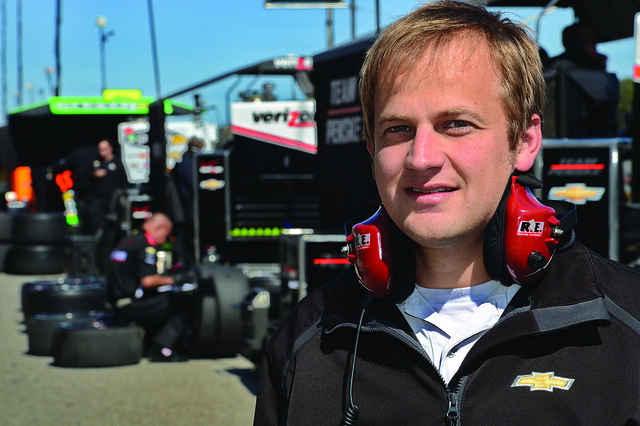Few professions are so overtly competitive as auto racing – the cameras follow the leaders and it’s all about winning. Finding a spot on a good team or support organization is just as hard in the small fraternity of race engineers who fly from track to track during the season. Like most of his colleagues, Charlie Ping, ’04 mechanical engineering, has not only moved from team to team learning the craft, but has been professionally active in different kinds of racing series as well – from LeMans Prototype to his current home in the IndyCar Series. We caught up with him at Birmingham’s Barber Motorsports Park.
Charlie Ping, ’04 mechanical engineering
Project manager, IndyCar race operations
Pratt & Miller
New Hudson, Mich.
Typical day . . . making the partnership between Pratt & Miller and Chevrolet work for all of the race teams running our engines. Chevrolet has tasked us to characterize the IndyCar vehicle and support Chevrolet powered teams in vehicle dynamics and simulation. When I get to the track, I coordinate with the trackside engineers in the race paddock, and we look at software, vehicle dynamics, testing and development issues. Every team has an embedded engineer, and each team has different needs, even though they are running essentially the same engine and chassis.
Engineering challenge . . . every team is trying hard to get a competitive advantage, and there’s always a lot of backchannel talk in the pits about who is doing what with the engine and chassis. Even little changes in your setup can make a lot of difference in track times . . . like when I hear a driver say, “I don’t understand this new tire!“ You know, it could be the track surface, the downforce on the racecar, the tire compound, or the temperature. The challenge is that the interaction of many factors comprises total vehicle performance and it is sometimes difficult to identify which areas are the most performance sensitive.
Living the life . . . in this kind of job, it can’t just be a job. It’s good if it is your hobby too . . . and your life. The travel schedule is demanding. Last year I took more than 1OO flights testing the new car and engine at different tracks, because they all treat the car differently. The track at Sebring is not like the one at Texas, and Texas is not like the oval at Fontana, it’s that simple. We don’t race in the snow, so racing generally follows good weather . . . which also means that I am not in Michigan often in the summer, which is the nicest time of year in the Midwest . . . sometimes I get tired, but I don’t really get tired of being at the track.
Geek moment . . . don‘t ask me how smart you have to be for this job. I can feel pretty stupid around here, if you want an honest answer. In this business, you can get humbled really quick, because a vehicle and its interaction with the circuit is such a complex problem . . . you have to be analytical . . . and you have to pay your dues.
Sense of pride . . . I have such a deep appreciation of technology and engineering, and I love what I call ‘pure engineering development‘ . . . the kind that I am exposed to during the off-season. It gets a little crazier at the track because the emphasis is so much on immediate results. It has to be – that‘s why we have the jobs we have.
My Auburn Engineering . . . I was lucky to have some great experiences at Auburn with the Formula SAE team including one of its best-ever finishes in collegiate competition . . . that allowed me to jump into this difficult business and hold my own . . . and I‘m having a blast.

